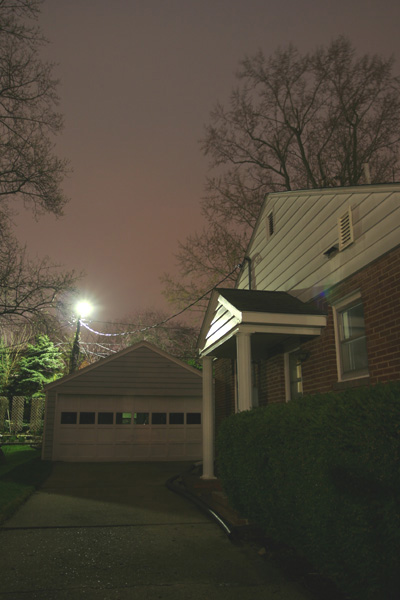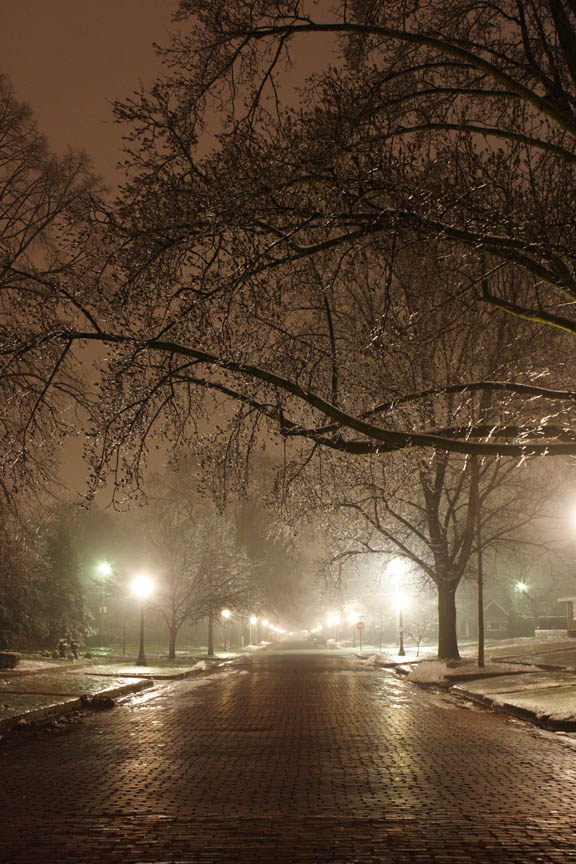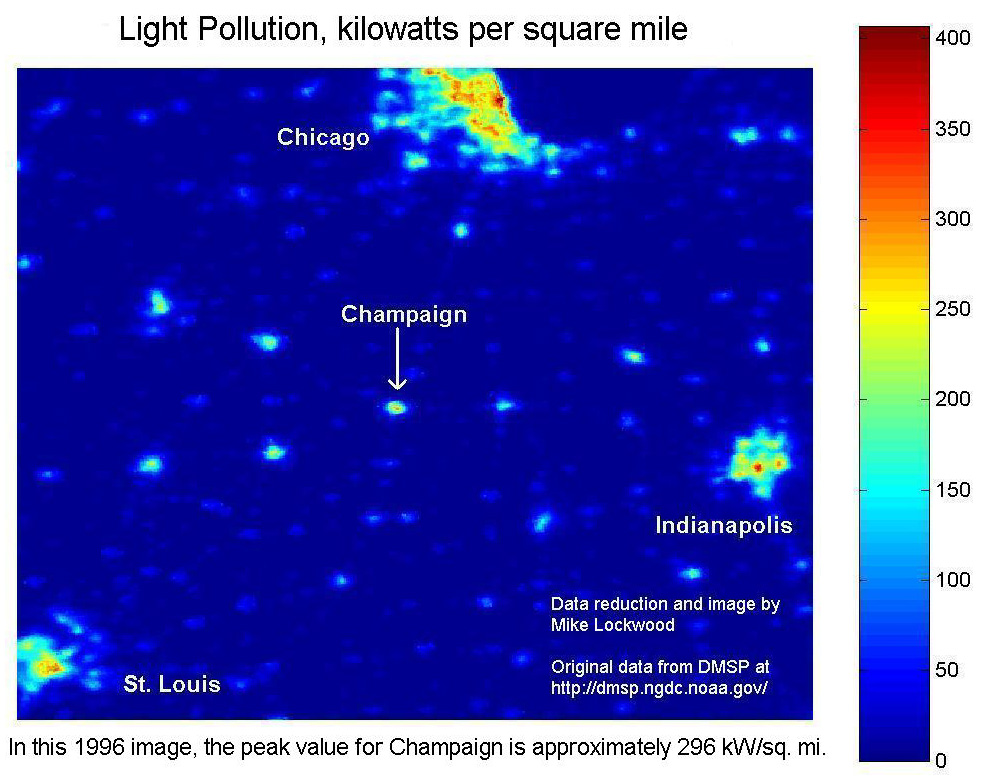Mike Lockwood's Light
Pollution Page
All photos and text Copyright Michael
E. Lockwood, 2006, 2007, 2008.
Why post this page? Because I'm mad. Not one square inch of
my property is free of glare from someone else's "insecurity" light or
city streetlights. This shouldn't be legal.
Think about this - I can be ticketed for leaving lawn waste on my
property or playing my stereo too loud, but my neighbors and the city
have the right to flood my property (including the inside of my house)
and the sky above with unwanted, wasted photons? How does that
make sense?
Even though I am an amateur astronomer and I feel strongly that
everyone should have access to reasonably dark skies outside their own
home, I will state that public safety and energy efficiency are more
important issues. Good lighting is necessary for some streets and
some locations, but good lighting contributes much less to sky glow
than poor lighting. Poor lighting glares in your eyes as you look
around or drive, and makes it more difficult to see criminals,
pedestrians and animals at night. In many cases, poor lighting
makes driving more dangerous than having no lighting at all. Ever
been blinded by glare from a poorly-aimed high-intensity lamp on the
interstate or on an overpass? I have. Ever notice that that
light in your backyard casts dark shadows that allow a would-be
criminal to hide there, unseen? I have.
Good lighting uses fixtures that have shields which keep light shining
down, as it should, and not up or to the side, which causes waste and
glare.
In addition to improving public safety at night, good lighting uses a
FRACTION of the light that bad lighting does. That should get
your attention, given the recent 50% hike in electric rates that was
rammed down comsumers' throats.
Additionally, many dusk-to-dawn lights could be eliminated if motion
detectors were installed. These units are inexpensive and turn
the light on when something moves. Even if the wind or animals
trigger them to come on, they go off after a few minutes and use much
less power than a dusk-to-dawn light.
There is absolutely no debate about these facts, but most people don't
seem to be getting the message. It was estimated that in the
mid-90s, the U.S. wasted $2 billion on poor lighting. That figure
is surely higher with the sprawl of suburbia increasing.
Let me illustrate my own (very bright) situation. When I moved
into my house, there were NO street lights. Some months later
these new "antique" globe light fixtures were installed. Below
are photos of my street and my garage, taken on a cloudy night.
The exposures were about 5 seconds, and show the scenes very close to
how they appear to the eye.

Note how little of the street is lit,
but how much of the sidewalk,
yards, and fronts of houses are lit! Also, note the
unnatural pink glow in
the sky - this is almost entirely due to wasted light - light that
emerges from a fixture and does nothing useful. (Doing something
useful is defined as lighting a street or parking lot for safety
reasons.) The glow is essentially wasted energy from businesses
and YOUR WASTED TAX DOLLARS. The bright fixtures represent
distractions for drivers and glare for those who are trying to observe
activity on the street (see my letter to the editor below). The
lights in this image are wasting over 50% of the light they emit - half
of the light goes up, and large portion of the light that hits the
ground of the light goes to light up yards and the fronts of
houses. So much for calling them "street lights".
Next is a photo of my neighbor's "insecurity" light, which is located
on a pole some two feet from the property line. It lights my
entire backyard and both bedrooms in my house. This is the
classic design that the power company charges you something line $13
per month to have on from dusk until dawn. However, it wastes a
large portion of the light that it puts out. At some point I am
going to try to have the power company shield this light so that none
of it goes up or onto my property. We'll see how that goes.

Here's one more photo of my street just after a recent round of
freezing rain. Notice just how much light is being wasted
lighting the trees, yards, fog, and sky, and how the illumination level
of the street is quite unimpressive. In fact, this makes for
ideal lighting for tree photography at night! Notice again the
unnatural, ugly dirty pink glow of the sky. What a shame, and
WHAT A WASTE! In the photo the waste just goes on and on into the
distance.

Below is a letter to the editor that I wrote that was published in the
Champaign News-Gazette last year concerning the poor street lighting
that was installed only recently in my neighborhood, because uninformed
residents (who were more concerned about property values than waste and
safety) voted to have "antique" looking fixtures installed. (In
addition to the events described below, I nearly hit a trick-or-treater
backing out of my driveway one rainy Halloween night because of the
glare of the lights in my eyes and car mirrors.)
Globe Lights Waste your Tax Dollars
Dear Editor,
One
recent evening I called police to a disturbance down the
street. The situation escalated; the
operator asked for details of the vehicle, people involved, and what
was
happening. However, I could not make
out the license plate, the color, or make of the vehicle, or the number
of
people involved even though I was less than a block away!
Why?
Because poor
lighting is provided by the globe “streetlights” in my
neighborhood.
While the lights shone in my eyes, blinding
me (they shine in drivers’ eyes, too), they cast little light upon the
situation that soon summoned six police cars to the scene. They
cannot be called “street lights” - they
are simply wasters of energy.
About 25% of
the light from these fixtures hits the street
and sidewalk. Another 25% goes to
illuminate yards and fronts of nearby houses, and a 50% radiates
upward,
blotting out stars and uselessly lighting up the undersides of trees,
clouds,
birds, and airplanes. Friends and
neighbors, your tax dollars funded these fixtures because of their
appearance,
but they waste your money every time they come on and can’t adequately
light
the streets.
If fitted
with internal shields, these fixtures could use
50% less energy and do a better, safer job of lighting the many streets
that
are lined with them. Their daytime
appearance would be unchanged. In an
age where energy conservation becomes more important every day,
Champaign,
Urbana, and the University of Illinois should not tolerate this
excessive
waste.
Mike
Lockwood
Champaign
Lastly, here I'll include some links and one last image. First,
the links (more to be added):
http://www.darksky.org/
- Internation Dark Sky Association - an
organization devoted to education about light pollution
Below is an image that I produced from publicly available
data. It shows the area surrounding Champaign, Illinois.
Based on calibrated radiance images from a satellite, I converted the
units of brightness to units of electrical usage, in terms
kilowatt hours. I must point out that this electrical usage only
includes the energy that is converted to light, and does not include
the energy that is wasted by every light bulb in the form of heat, so
the electricity wasted by bulbs that could be reduced in wattage (if
reflectors or shields were added) is NOT included in this plot of
wasted energy.

As far as I know, I have done the data conversion correctly. 296
kW per square mile is the equivalent of having 3000 lights wasting 100
W each in one square mile. When you look at the lighting on
campus or near warehouses, this appears quite consistent. I
suspect the peak value is from the Memorial Stadium lights.



